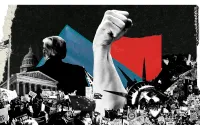Februaray 10 2011
Some prominent congressional leaders and media pundits, in a cynical effort to mislead the American public into supporting the Egyptian dictatorship of Hosni Mubarak and opposing the popular nonviolent struggle for democracy, have raised the specter of Egypt’s government falling into the hands of radical Islamists who would attack Israel and support international terrorism. To illustrate this frightening scenario, these apologists for authoritarianism try to compare the current pro-democracy uprising against the U.S.-backed Egyptian dictatorship of Hosni Mubarak with the 1978-79 insurrection against the U.S.-backed Iranian dictatorship of Shah Reza Pahlavi.
These backers of the Egyptian dictator point out that the Iranian revolution was, like the current uprising in Egypt, initially a broad-based movement of young left-leaning activists struggling for greater democracy. They note, however, that not long after the Shah’s overthrow, the Iranian government was taken over by anti-democratic Islamist clerics and their allies who soon turned Iran into a brutal authoritarian theocratic state whose repression soon surpassed even that of the ousted U.S.-backed monarch.
In reality, there is virtually no chance that Egypt will take such a tragic turn should the revolution succeed in, not only overthrowing Mubarak, but ousting his allies in the military and ruling party. Indeed, comparing the possible popular overthrow of the Egyptian regime with that of the Shah is completely ahistorical.
More accurate analogies to the current struggle in Egypt would include the popular nonviolent insurrections that ousted the right-wing Latin American military juntas in Chile and Bolivia, the authoritarian Asian regimes in Mongolia, the Philippines and Nepal, the Eastern European Communist systems in Poland, East Germany ,and Czechoslovakia,, the African dictatorships in Madagascar and Benin, the post-Communist autocrats in Serbia and Ukraine, and more than a dozen other repressive regimes including such Muslim countries as Mali, Indonesia, Bangladesh, and the Maldives. The transition away from authoritarianism has been smoother in some of these countries than in others, but virtually all of them – including those in which Islamist played a role in the pro-democracy struggle – are democracies at this point.
Not Iran 1979
The difference between Egypt today and Iran of the late 1970s is striking.
The direction of the anti-Shah movement in Iran from the outset came from the exiled Ayatollah Khomeini and other Shiite Muslim clerics. Inspirational sermons, tactical advice, and specific calls for strikes and demonstrations came through smuggled cassette tapes, radio broadcasts, and other communication from the clerical leadership. Though many on the ground in the struggle against the Shah were leftists and other secular democratic forces – some of whom organized important strikes, demonstrations, and other actions independently from the religious hierarchy – the religious overtone of the demonstrations was apparent in the slogans, communiqués, banners, graffiti, and other means throughout the 13-month struggle that led to the Shah’s overthrow in February 1979.
The overwhelming role played by religious forces in Iran contrasts with the ongoing demonstrations, strikes, and other actions in Egypt, which has been led from the outset by secular youth through the Internet and other means of communication. The slogans, communiqués, banners, graffiti, tweets, and Facebook messages have been almost exclusively secular in orientation, pushing nationalistic and liberal democratic themes. And, despite decades of U.S. support for the Mubarak dictatorship, the Egyptian protests have featured virtually no explicit anti-Americanism, a striking contrast with the Iranian revolution. Indeed, the current protests have almost exclusively focused on Mubarak’s misrule rather than the U.S. role in enabling it.
Although most of the Egyptian protesters are presumably practicing Muslims, they show no desire to establish an Islamic state, which was an explicit demand of much of the Iranian revolution’s leading activists from the beginning of the struggle.
The Shah's forced secularization of Iranian society – which was merged in the minds of many Iranians with authoritarianism, corruption, inequality, and Western imperialism – helped create the Islamist reaction. By contrast, Mubarak’s regime, although nominally secular, quietly worked with conservative Muslim elements both to placate religious Egyptians – by expanding religious programming in the media, engaging in religiously based censorship, and discrimination against the country’s Coptic Christian minority – as well as to mobilize some pro-regime Islamists to attack liberal and leftist opponents.
Another key distinction is that Iranian Muslims are overwhelmingly from the Shiite tradition, whereas Egyptian Muslims are Sunni. Shiites have a clear religious hierarchy; ayatollahs are essentially the equivalent of cardinals in the Catholic Church, with schools, medical facilities, social services, and businesses – not to mention houses of worship and large numbers of clergy – under their direct control. Iranian clerics had strong organizational networks under their command they could mobilize and consolidate against democratic secular forces in aftermath of the Shah’s overthrow.
By contrast, Sunnis have an egalitarian tradition. Some clerics may have a bigger following than others, but – unlike Shiites – they do not have a privileged class of spiritual leaders whom believers are obliged to obey. While the Muslim Brotherhood and other Islamic groups have supported a network of health care clinics and other social services in Egypt, their leadership does not have anything close to the mobilizing capacity the Shiite clerics had in Iran. Indeed, according to Abdel Moneim Aboul Fotouh, a former member of the group’s Guidance Council, they only operate half a dozen clinics in Cairo, a city of 18 million people.
The ayatollahs influence in Iranian society ended up determining the outcome of the Iranian revolution due to the thoroughness by which the Shah, through his dreaded U.S.-trained SAVAK (secret police), decimated the secular democratic opposition. The mosques and the Shiite religious institutions, by contrast, were much harder to penetrate and suppress and were thereby in a better position to take advantage of the power vacuum after the Shah’s fall.
Most significantly, compared with Iran in the 1970s, Egypt today has a much stronger civil society, a more literate and educated population, greater access to information technologies that didn’t exist in Iran or anywhere else 30 years ago, and – despite serious economic hardships – a larger middle class . Egypt also has a strong tradition of political parties going back to the nineteenth century. Though Egypt has for decades been a one-party state in terms of governance, and elections have been routinely stolen, there are well-established legal political parties. These include the New Wafd, Al-Ghad (“Tomorrow”), the National Progressive Unionists, the Nasserists, the Liberals (Ahrar), and more than a dozen others, virtually all liberal or left-wing.
In addition to these secular political parties, major secular pro-democracy groups include Kefaya (Enough!) and the April 6 Movement, the primary organizers of the recent demonstrations. Industrial labor unions and professional associations are far more prominent in the current demonstrations and in Egyptian society overall than they were in Iran at the time of the revolution. And, unlike Iran under the Shah, Egypt has virtually no prominent dissident Islamic clergy.
Another key distinction between Iran in the 1970s and Egypt today is economic. In Iran, the powerful traditional merchant class – known as bazaaris – was bitter at the Shah’s draconian taxation, fines, and other efforts to place them at a disadvantage to his preferred neo-liberal economic development model that brought in foreign investment, foreign consumer goods, and other competition. They found a natural affinity with the religious hierarchy, who opposed such Western economic (and other) penetration and with whom they had strong historical ties, including intermarriage. As a result, they threw their considerable political and economic influence into the consolidation of clerical rule.
By contrast, the comparable traditional merchant class in Egypt is largely dependent on the tourist trade. Although Iran’s foreign revenue overwhelmingly comes from its sizable oil exports, the number one source of foreign income for Egyptians has long been Western tourism, which would drop off considerably if Egypt fell under radical Islamist control. In addition, the merchant class in Egypt is disproportionately made up of Coptic Christians, who would obviously never support the establishment of an Islamist state.
In addition to the tourist trade, Egypt is far more dependent than Iran on good economic ties with Western countries in other ways as well. Egypt is the largest importer of grain in the world, most of which comes free of charge in the form of U.S. foreign aid. The country’s very economic survival would be a stake if it developed a hostile relationship with the West. Iran, by contrast, is one of the world’s largest oil exporters and – despite U.S. sanctions – has always had a steady source of outside revenue without foreign tourists or foreign aid.
The Muslim Brotherhood
U.S. apologists for the Egyptian dictatorship point to the fact that the largest single opposition group – and arguably best organized – is the Muslim Brotherhood, a movement which has played a role in Egyptian politics since the 1920s. Being the single largest opposition group, however, does not mean that the Muslim Brotherhood has majority support – far from it. Most estimates put their popular support at 20-15 percent, with the upper estimate at 30 percent or slightly higher. Its active adherents probably number no more than 100,000 out of a population of over 82 million. There are also serious divisions between the more progressive and more conservative elements within the movement, and it would likely split into two or more political parties once legalized. Indeed, according to the Egyptian newspaper El-Masry El-Youm, both the women’s and youth wing appear to have already split from the Muslim Brotherhood last week and joined the April 6 Movement.
Many Egyptians have been attracted to the Brotherhood simply because it was the largest and best-organized opposition to the dictatorship. With Mubarak gone and a democratic order in place encouraging a plethora of other political movements to organize without fear or political repression, many more visible and viable choices would be available to the Egyptian voter.
The young activists of Kefaya and the April 6 Movement consider the Muslim Brotherhood and its aging leadership to be as out of touch with their day-to-day realities as the regime. A full 60 percent of Egypt’s population is under 30 years of age and – like young people in most countries – their attitudes regarding the role of women, sexuality, and related issues tends to be more tolerant than their elders, so the Muslim Brotherhood’s social conservatism is not very appealing. In addition, since the Brotherhood has had a hard time recruiting younger members in recent years, their median age is much older than almost any other political grouping. The young people who have joined the movement during the past decade or so have tended to be modernists and reformers.
Also limiting the Muslim Brotherhood’s appeal is that it not only refused to endorse the smaller protests and strikes of the young pro-democracy activists in the years leading up to the current uprising, it offered only a half-hearted and very belated endorsement of the massive protests of January 25 that launched the pro-democracy insurrection. Although their support for the demonstrations became more visible subsequently as the popular struggle gained momentum, this apparent opportunism has undoubtedly weakened their standing among those committed to creating a new Egypt.
U.S. officials in the State Department and elsewhere familiar with Egyptian politics, even under the Bush administration, have long dismissed claims that the demise of the Egyptian regime would lead to a fundamentalist state. U.S. ambassador to Egypt Frank Ricciardone argued in a January 2006 cable recently made public through Wikileaks that “We do not accept the proposition that Egypt's only choices are a slow-to-reform authoritarian regime or an Islamist extremist one; nor do we see greater democracy in Egypt as leading necessarily to a government under the MB.” In another cable three months earlier, the ambassador noted how Egyptian authorities "have a long history of threatening us with the MB bogeyman."
Not only will the Muslim Brotherhood not likely play a major role in a post-revolutionary Egyptian government, it is not an extremist group like the Taliban. A number of radical Islamist organizations, ranging from the Palestinian Hamas to the Egyptian Islamic Jihad, split off from the Muslim Brotherhood several decades ago. Today’s Brotherhood is a relatively moderate organization committed to electoral politics and nonviolent organizing. It formally renounced armed struggle more than 40 years ago and has repeatedly condemned terrorism, particularly the large-scale international terrorism of al-Qaeda.
The Muslim Brotherhood’s so-called “al-Qaeda link” cited by U.S. apologists for the Egyptian dictatorship primarily is in regard to Ayman Al-Zawahiri, who had been a Muslim Brotherhood activist as a teenager and much later went on to co-found the terrorist organization with Osama bin Laden. Al-Zawahiri, however, rejected the Brotherhood precisely because of its rejection of violence and relatively moderate politics, which he denounced as a “betrayal” of “Islamic principles.” According to the al-Qaeda second-in-command, the Muslim Brotherhood was “falsely affiliated with Islam” because its leadership allegedly “forget about the rule of Shariah, welcome the Crusaders’ bases in your countries and acknowledge the existence of the Jews.”
In a democratic election, the Muslim Brotherhood would likely win scores of seats in the 454-member lower house and could even conceivably be a junior partner in a coalition government. But its political orientation would not be much different from the legal conservative Muslim-identified parties currently in the Jordanian and Moroccan parliaments or even the ruling Justice and Development Party in Turkey. Indeed, the Muslim Brotherhood would likely be more moderate and more committed to the democratic process than some of the hard-line fundamentalist Jewish parties in the current ruling coalition government of Israel, America’s closest ally in the Middle East.
Though strongly anti-Israel, the Muslim Brotherhood recognizes along with the Egyptian armed forces that Israel cannot be defeated militarily. Egypt fought four wars with Israel between 1948 and 1973 and lost each one badly at considerable costs; the military balance is even more skewed in Israel’s favor today. Support for terrorist groups would invite devastating Israeli military reprisals. With so many desperate economic and other domestic problems to deal with in a post-Mubarak era, the last thing Egyptians would support is a war with a powerful neighbor they would surely lose. Although a democratic Egyptian government would likely be more outspoken in support of the Palestinian cause and in opposition to the current right-wing Israeli government – and would likely ease the blockade of food, medicines and other humanitarian goods into the besieged Gaza Strip – it would never abrogate Egypt’s 1978 peace agreement with Israel. Too much U.S. aid depends on maintaining the agreement.
Nonviolent Democratic Change
Virtually all of the largely nonviolent civil insurrections around the world over the past three decades have led to democratic governance and moderate secular leadership. There is little reason to suspect Egypt would be different. Such nonviolent revolutions require the building of broad coalitions that help encourage pluralism and compromise, empower ordinary people, and build civil society. This creates not just political change but fundamental social change of the kind that has the will and the means to resist potential encroachments against newfound democratic institutions and individual liberties.
Such movements contrast with armed struggles against authoritarian governments, where martial values predominate and an elite vanguard controls the course of the revolution, more often than not resulting in another dictatorship.
Even more problematic is when a dictator is overthrown through outside intervention, since the newly installed regime dependent on a foreign occupying force tends to result in its delegitimization in the eyes of their citizens, creating a nationalist reaction that could lead to a violent insurrection that in turn leads to repressive rule. Indeed, this is exactly what has taken place in Iraq. Ironically, most of the prominent American pundits and politicians now claiming that Egypt’s nonviolent indigenous struggle against Mubarak will result in a repressive Iranian-backed fundamentalist regime are some of the very people who supported the U.S. invasion of Iraq – which has resulted in a repressive Iranian-backed fundamentalist regime.
A democratic Egyptian government will certainly take more independent positions from the United States on some strategic and economic issues. It would likely be less amenable to the dictates of the International Monetary Fund and other international financial institutions. Being dependent on the will of the Egyptian people for its authority, such a government will likely be relatively nationalistic, attempting to prioritize the needs of Egyptians more than the current authoritarian regime has felt obliged to do.
However, while a democratic Egypt – which could help pave the way for greater democracy elsewhere in the Arab world – may set back certain perceived U.S. strategic and economic interests in the short- to medium-term, it would be the best thing that could happen in the long-term.
Terrorism and extremism, Islamic and otherwise, tend to grow out of authoritarian societies where it becomes impossible to address grievances, defend human rights, and demand social and economic justice through democratic means. “The images of intimidation and fraud that have emerged from the recent elections favor the Islamist extremists whom we both oppose," Ambassador Ricciardone acknowledged in a cable to FBI director Robert Mueller following the 2005 Egyptian elections. "The best way to counter narrow-minded Islamist politics is to open the system.” It's no surprise that virtually all of al-Qaeda’s leaders and financial backers – and a large majority of its members – have come from countries ruled by U.S.-backed dictators like Mubarak.
For its overall national security interests, then, the United States must end its support of the Mubarak regime and other Middle Eastern dictators and welcome nonviolent democratic movements for change.






